Opole
Opole (Polish: [ɔˈpɔlɛ] (![]()
Opole | |
|---|---|
 Old Town | |
 Coat of arms | |
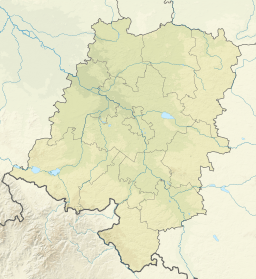 Opole 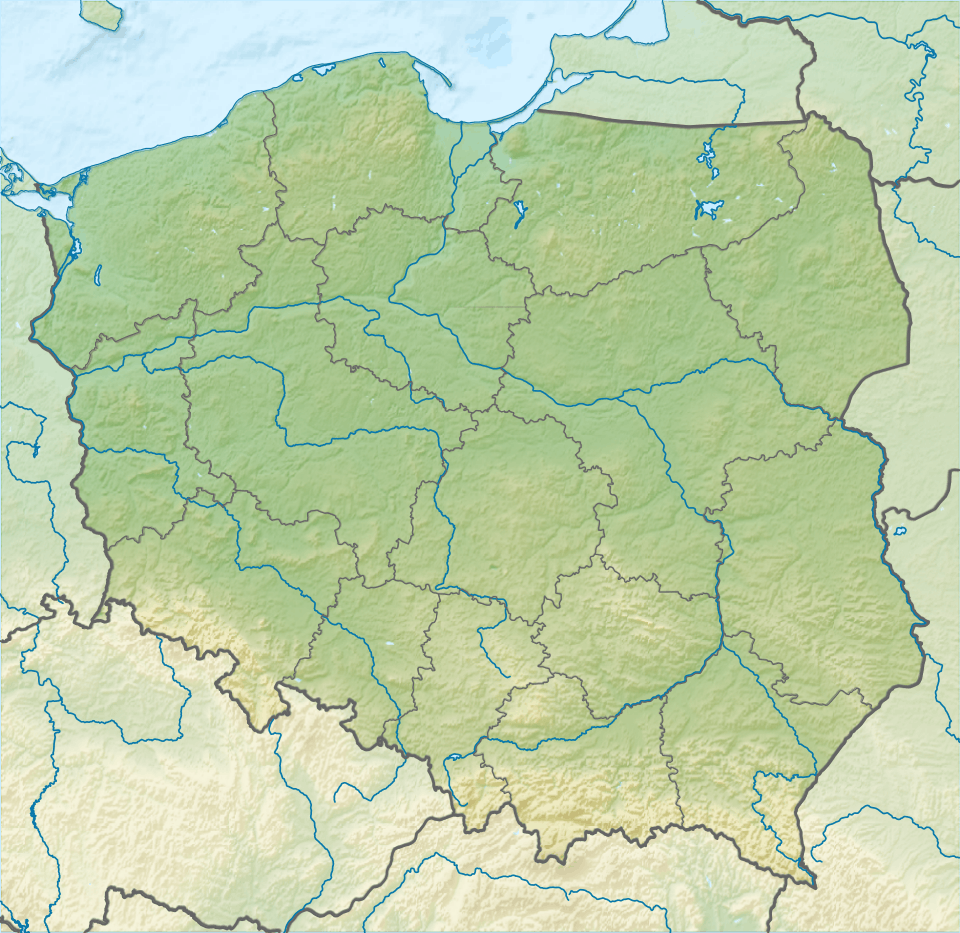 Opole  Opole | |
| Coordinates: 50°40′N 17°56′E | |
| Country | Poland |
| Voivodeship | Opole |
| County | city county |
| Town rights | 1217 |
| Government | |
| • Mayor | Arkadiusz Wiśniewski |
| Area | |
| • City | 148.99 km2 (57.53 sq mi) |
| Elevation | 176 m (577 ft) |
| Population (31 December 2019) | |
| • City | 128,035 |
| • Metro | 267,000 |
| Time zone | UTC+1 (CET) |
| • Summer (DST) | UTC+2 (CEST) |
| Postal code | 45-001 to 45-960 |
| Area code(s) | +48 077 |
| Car plates | OP |
| Website | https://www.opole.pl |
The origins of the first settlement are connected with the town being granted Magdeburg Rights in 1217 by Casimir I of Opole,[2] the great-grandson of Polish Duke Bolesław III Wrymouth. During the Medieval Period and the Renaissance the city was known as a centre of commerce due to its position on the intersection of several main trade routes, which helped to generate steady profits from transit trade. The rapid development of the town was also caused by the establishment of a seat of regency in Opole in 1816. The first railway connection between Oppeln, Brieg and Breslau was opened in 1843 and the first manufacturing plants were constructed in 1859, which greatly contributed to the city's regional significance.[3]
The city's extensive heritage entails almost all cultures of Central Europe including years of Polish, Bohemian, Prussian and German rule. Opole formally became part of Poland again in 1945 under the Potsdam Agreement. Many German Upper Silesians and Poles of German ancestry still reside in the Opole region; in the city itself, however, ethnic Germans today make up less than 3% of the population following the 1945–6 expulsions.
Today there are four higher education establishments in the city: The Opole University, Opole University of Technology, a Medical College and the private Higher College of Management and Administration. The National Festival of Polish Song has been held here annually since 1963 and each year new regular events, fairs, shows and competitions take place.[4]
Opole is sometimes referred to as "Polish Venice",[5] because of its picturesque Old Town and several canals and bridges connecting parts of the city.
Names and etymology
The name Opole likely originated from the medieval Slavic term for a group of settlements.[6]
Names for the city in other relevant languages include Lower Silesian: Uppeln, Czech: Opolí, Latin: Oppelia, Oppolia or Opulia.
History
In Medieval Poland

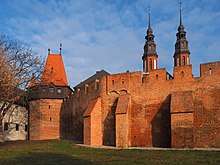
Opole's history begins in the 8th century. At this time, according to the archeological excavations,[7] the first settlement was founded on the Ostrówek – the northern part of the Pasieka Island in the middle of the Oder river. In the early 10th century it developed into one of the main "gords" of the West Slavic Opolans tribe.
At the end of the century Silesia became part of Poland and was ruled by the Piast dynasty; the land of the pagan Opolanie was conquered by Duke Mieszko I in 992. From the 11th–12th centuries it was also a castellany. After the death of Duke Władysław II the Exile, Silesia was divided in 1163 between two Piast lines – the Wrocław line in Lower Silesia and the Opole-Racibórz of Upper Silesia. Opole would become a duchy in 1172 and would share much in common with the Duchy of Racibórz, with which it was often combined. In 1281 Upper Silesia was divided further between the heirs of the dukes. The Duchy of Opole was temporarily reestablished in 1290.
In the early 13th century, Duke Casimir I of Opole decided to move the settlement from the Pasieka Island into the right shore of the Oder river (since the 17th century it is the old stream bed of Oder known as Młynówka). All of the inhabitants had to be moved in order to make place for the castle that was eventually built in the place of the old city.[8] Former inhabitants of Ostrówek together with German merchants that immigrated here from the West, received first town rights probably as early as around 1217, although this date is disputed.[9] Opole received German town law in 1254, which was expanded with Neumarkt law in 1327. Opole developed during the rule of duke Bolko I of Opole. In this time the castle was finally completed and new buildings, including the city walls and the Holy Cross Church, were constructed.
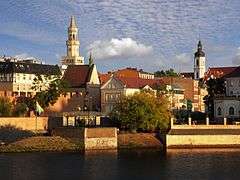
Along with most of Silesia, in 1327 the Duchy of Opole came under the sovereignty of the Kingdom of Bohemia, itself part of the Holy Roman Empire. In 1521 the Duchy of Racibórz (Ratibor) was inherited by the Duchy of Opole, by then also known by its German equivalent – Oppeln. The second castle of Opole was probably founded in the 14th century by duke Vladislaus II, though some sources claim that it was originally a wooden stronghold of Opole's castellan dating into 12th century.[10]
Austrian Habsburgs and Polish Vasas rule
With the death of King Ludvík II of Bohemia at the Battle of Mohács, Silesia was inherited by Ferdinand I, placing Opole under the sovereignty of the Habsburg Monarchy of Austria. The Habsburgs took control of the region in 1532 after the last Piast duke of Opole – Jan II the Good died. In those days the city was still mainly Polish-speaking (around 63%), with other nationalities represented mainly by Germans, Czechs and Jews. The last two dukes of Opole, Nicholas II and Janusz II the Good, did not master the German language.[11]
Beginning in 1532 the Habsburgs pawned the duchy to different rulers including several monarchs of Poland (see Dukes of Opole). After the Swedish invasion of Poland, in 1655 the King of Poland, John II Casimir Vasa, stayed with the entire court in Opole. In Opole in November 1655, the Universal of Opole (Uniwersał opolski) was issued by the King, calling for Poles to rise against the Swedes, who at that time occupied a large part of Poland.

With the abdication of King John II Casimir of Poland as the last Duke of Opole in 1668, the region passed to the direct control of the Habsburgs. At the beginning of the 18th century the German population of Opole was estimated at around 20%.[12]
In Prussian Silesia
King Frederick II of Prussia conquered most of Silesia from Austria in 1740 during the Silesian Wars; Prussian control was confirmed in the Peace of Breslau in 1742. During the Prussian rule the ethnic structure of the city began to change. In the early 20th century the number of Polish and bilingual citizens of Opole, according to the official German statistics, varied from only 25% to 31%.[13] Nonetheless, Opole remained an important cultural, social and political center for the Poles of Upper Silesia. From 1849 the Polish newspaper Gazeta Wiejska dla Górnego Śląska was published in Opole. Polish reporter and opponent of Germanisation Bronisław Koraszewski founded the newspaper Gazeta Opolska in 1890 and the People's Bank in Opole (Opolski Bank Ludowy) in 1897.[14] Another Polish newspaper, the Nowiny was founded by Franciszek Kurpierz in 1911.
From 1816–1945 Opole was the capital of Regierungsbezirk Oppeln within Prussia. The city became part of the German Empire during the unification of Germany in 1871.

After World War I
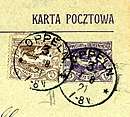
After the defeat of Imperial Germany in World War I, a plebiscite was held on 20 March 1921 in Oppeln to determine if the city would be in the Weimar Republic or become part of the Second Polish Republic. 20,816 (94.7%) votes were cast for Germany, 1,098 (5.0%) for Poland, and 70 (0.3%) votes were declared invalid. Voter participation was 95.9%. Results of the plebiscite in the Oppeln-Land county were different, with 30% of the population voting for Poland.

Oppeln was the administrative seat of the Province of Upper Silesia from 1919–1939. In the years 1928–1931, by the decision of the German regional administration, the Piast Castle was demolished. Thanks to the strong opposition of the local Polish community and protests of the Union of Poles in Germany, at least the castle tower was saved from demolition.[15] Nowadays called the Piast Tower it is one of the city's landmarks. In 1929, a Polish theatre from Katowice came to Opole for a performance of the opera Halka by Stanisław Moniuszko. After the performance, the actors were brutally beaten by a German militia with the silent consent of the German police.[16]
With the defeat of Poland in the invasion of Poland at the beginning of World War II in 1939, formerly Polish Eastern Upper Silesia was re-added to the Province of Upper Silesia and Oppeln lost its status as provincial capital to Katowice (renamed Kattowitz).

On 15 February 1941 and 26 February 1941, two deportation transports with 2,003 Jewish men, women and children on board left Vienna Aspang Station for the ghetto which had been set up in Oppeln. By March 1941, 8,000 Jews were deported to Oppeln. From May 1941, 800 men capable of work were deployed as forced labourers in Deblin. The "Liquidation" of the Oppeln ghetto began in the spring of 1942. A transport to Belzec extermination camp left on 31 March 1942 and deportations to Sobibor followed in May and October 1942. Of the 2,003 Viennese Jews, only twenty-eight are known to have survived.
In modern Poland
After the end of the Second World War in 1945, Oppeln was transferred from Germany to Poland according to the Potsdam Conference, and given its original Slavic name of Opole. Opole became part of the Katowice Voivodeship from 1946–1950, after which it became part of the Opole Voivodeship. Unlike other parts of the so-called Recovered Territories, Opole and the surrounding region's indigenous population remained and was not forcibly expelled as elsewhere. Over 1 million Silesians who considered themselves Poles or were treated as such by the authorities due to their language and customs were allowed to stay after they were verified as Poles in a special verification process. It involved declaring Polish nationality and an oath of allegiance to the Polish nation.[17]
In the later years however many of them left to West Germany to flee the communist Eastern Bloc (see Emigration from Poland to Germany after World War II). Today Opole, along with the surrounding region, is known as a centre of the German minority in Poland that recruits mainly from the descendants of the positively verified autochthons. In the city itself however only 2.46% of the inhabitants declared German nationality according to the last national census of 2002.[18]
On January 1, 2017, Borki, Chmielowice, Czarnowąsy, Krzanowice, Sławice, Świerkle, Winów, Wrzoski, Żerkowice as well as parts of Brzezie, Dobrzeń Mały and Karczów became a part of Opole, enlargening its population by about 9,500, and its area by over 5,300 ha, despite the protests of inhabitants.[19][20]
Historical population
In the early 20th century the number of Polish and bilingual citizens of Opole, according to the official German statistics, varied from 25 to 31%.[13]
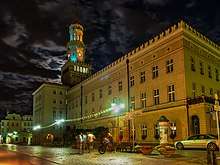
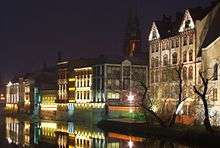
|
|
|
¹ First census of the city
² 8,320 German nationality (93.7%) and 557 Polish nationality (6.3%)
³ 80% German-speaking, 16% Polish-speaking, and 4% bilingual Polish-German-speaking

German minority
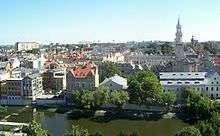
Alongside German and Polish, many citizens of Opole-Oppeln before 1945 used a strongly German-influenced Silesian dialect (sometimes called wasserpolnisch or wasserpolak). Because of this, the post-war Polish state administration after the annexation of Silesia in 1945 did not initiate a general expulsion of all former inhabitants of Opole, as was done in Lower Silesia, for instance, where the population almost exclusively spoke the German language. Because they were considered "autochthonous" (Polish), the Wasserpolak-speakers instead received the right to remain in their homeland after declaring themselves as Poles. Some German speakers took advantage of this decision, allowing them to remain in their Oppeln, even when they considered themselves to be of German nationality. The city surroundings currently contain the largest German and Upper Silesian minorities in Poland. However, Opole itself is only 2.46% German.[18] (See also Germans of Poland.)
Main sights
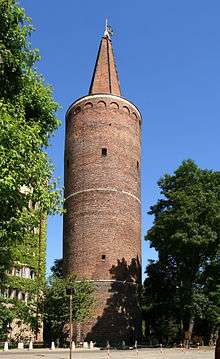
Opole hosts the annual National Festival of Polish Song. The city is also known for its 10th-century Church of St. Adalbert and the 14th-century Church of the Holy Cross. There is a zoo, the Ogród Zoologiczny w Opolu.
Structures and buildings
- Piast tower on the island (only part that remained of Piast castle)
- a 14th-century Franciscan church, a Piast mausoleum
- a 19th-century Town Hall
- the Church of our Lady of Sorrows and St. Adalbert (Kościół Matki Boskiej Bolesnej i św. Wojciecha)
- the 14th-century Holy Cross Cathedral (Bazylika katedralna Podwyższenia Krzyża Świętego)
- The art nouveau Penny Bridge (Most Groszowy), currently named Green Bridge (Zielony Mostek)
- Opole Main Station, an eclectic building from early 20th century.
Museums
- Diocesan Museum (Muzeum Diecezjalne)
- Opole Regional Museum (Muzeum Śląska Opolskiego)
- Opole Village Museum (Muzeum Wsi Opolskiej)
Cemeteries
Geography
Opole is one of the warmest cities in Poland. The national all-time heat record was measured in Prószków, near Opole.
| Climate data for Opole | |||||||||||||
|---|---|---|---|---|---|---|---|---|---|---|---|---|---|
| Month | Jan | Feb | Mar | Apr | May | Jun | Jul | Aug | Sep | Oct | Nov | Dec | Year |
| Record high °C (°F) | 15.8 (60.4) |
19.3 (66.7) |
25.0 (77.0) |
28.2 (82.8) |
32.6 (90.7) |
35.5 (95.9) |
38.0 (100.4) |
39.0 (102.2) |
35.4 (95.7) |
26.2 (79.2) |
21.9 (71.4) |
16.1 (61.0) |
39.0 (102.2) |
| Average high °C (°F) | 1.9 (35.4) |
3.7 (38.7) |
8.4 (47.1) |
15.7 (60.3) |
20.0 (68.0) |
23.1 (73.6) |
25.6 (78.1) |
24.7 (76.5) |
19.9 (67.8) |
14.0 (57.2) |
8.5 (47.3) |
2.8 (37.0) |
14.0 (57.2) |
| Daily mean °C (°F) | −0.5 (31.1) |
0.6 (33.1) |
4.2 (39.6) |
10.1 (50.2) |
14.4 (57.9) |
17.7 (63.9) |
19.9 (67.8) |
19.1 (66.4) |
14.8 (58.6) |
10.0 (50.0) |
5.6 (42.1) |
0.6 (33.1) |
9.7 (49.5) |
| Average low °C (°F) | −2.9 (26.8) |
−2.3 (27.9) |
0.0 (32.0) |
4.4 (39.9) |
8.9 (48.0) |
12.3 (54.1) |
14.4 (57.9) |
13.5 (56.3) |
9.5 (49.1) |
5.9 (42.6) |
2.8 (37.0) |
−1.6 (29.1) |
5.4 (41.7) |
| Record low °C (°F) | −25.2 (−13.4) |
−22.9 (−9.2) |
−15.6 (3.9) |
−6.8 (19.8) |
−4.4 (24.1) |
1.8 (35.2) |
5.0 (41.0) |
1.0 (33.8) |
−1.5 (29.3) |
−6.7 (19.9) |
−12.9 (8.8) |
−22.5 (−8.5) |
−25.2 (−13.4) |
| Average precipitation mm (inches) | 34 (1.3) |
29 (1.1) |
32 (1.3) |
29 (1.1) |
59 (2.3) |
66 (2.6) |
73 (2.9) |
46 (1.8) |
47 (1.9) |
29 (1.1) |
31 (1.2) |
34 (1.3) |
494 (19.4) |
| Average precipitation days | 16 | 13 | 14 | 11 | 13 | 12 | 13 | 9 | 11 | 11 | 13 | 15 | 151 |
| Average relative humidity (%) | 83 | 81 | 76 | 71 | 72 | 73 | 72 | 74 | 78 | 79 | 83 | 84 | 77 |
| Mean monthly sunshine hours | 48 | 70 | 127 | 191 | 225 | 224 | 238 | 221 | 151 | 108 | 56 | 41 | 1,698 |
| Source 1: | |||||||||||||
| Source 2: http://climatebase.ru/station/12530/?lang=en | |||||||||||||
Education
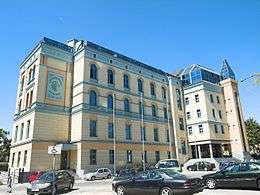
- state-run universities and colleges:
- privately run colleges:
- Management and Administration College in Opole (Wyższa Szkoła Zarządzania i Administracji w Opolu)
- Bogdan Jański Academy (Szkoła Wyższa im. Bogdana Jańskiego)
- WSB Universities - WSB University in Wrocław,[23] departments of Economics
Politics

Members of Parliament (Sejm) elected from Opole constituency
- Danuta Jazłowiecka, PO
- Tadeusz Jarmuziewicz, PO
- Ryszard Knosala, PO
- Leszek Korzeniowski, PO
- Sławomir Kłosowski, PiS
- Teresa Ceglecka-Zielonka, PiS
- Mieczysław Walkiewicz, PiS
- Henryk Kroll, German minority
- Ryszard Galla, German minority
- Józef Stępkowski, Samoobrona
- Sandra Lewandowska, Samoobrona
- Tomasz Garbowski, SLD
- Marek Kawa, LPR
Economy

Opole is the Opole Voivodeship's centre for commerce, banking, industrial complexes and other major service sector industries.[24][25][26]
Prior to World War II, due to major limestone deposits in Opole's vicinity, the city developed as a centre for cement production in Germany, with the Cementownia "Odra" being active till this day. The French building materials company Lafarge is also active in the area, having its roofing division, Lafarge Roofing, together with its German subsidiary Schiedel (chimney manufacturing) based in Opole.[27]

Other companies in the city include: the German valve manufacturer Kludi; the German men's fashion manufacturer Ahlers and the American automotive manufacturer Tower Automative. As is the case with the entire Opole Voivodeship, there is a strong presence of food industry services in the city. The largest companies in the food sector include: Zott, the Dutch baby food and nutrition company Nutricia, part of the Danone food-products corporation.
Opole has branches of all major banks, including: PKO, Pekao, Deutsche Bank and Raiffeisen Zentralbank.
The retail sector in Opole includes major Metro AG brand stores: Metro Cash and Carry and Media-Saturn-Holding, as well as Real. The city has a plethora of other major supermarket chains, namely: the Polish supermarket chains Biedronka, Lidl, Aldi and Netto.[28] Other major brand stores include the shoe retailer Deichmann and Rossmann drugstores.[29]
Furthermore, the city has three major shopping centres. The Solaris Center, with a total of 86 shops, opened in May 2009 and is located in the centre of Mikołaj Kopernik Square. In the city's suburbs, by Wrocławska Street (ul. Wrocławska) is the location of Karolinka Shopping Centre (Centrum Handlowe Karolinka). The shopping centre, which opened in September 2008, has a total area of 38,000 m², with a total of 99 stores, including fashion, hardware and electronics stores. To the east of the city, by the National Road 46, is the smallest of the three shopping centres, Turawa Park, with a total of 50 stores. Other shopping centres include Galeria Opolanin, built between 1974 and 1981 and upon its completion, was the largest shopping centre in Poland.[30]
Sports
Among the city's most popular sports team are:
- Odra Opole – football club, playing in the Polish second division. From the 1950s to the 1980s the team competed in the country's top-flight, finishing 3rd in 1964.
- Orlik Opole – ice hockey club, playing in the Polish Hockey League, the country's top division.
- Kolejarz Opole – speedway club, competing on the Polish third tier. In the 1970s and 1980s, the team competed in the country's top-flight, finishing 3rd in 1970.
- Gwardia Opole – handball club, playing in the Polish Superliga, the country's top division, and finishing 3rd in 1964 and, recently, in 2019.
Notable people
- Vladislaus II of Opole, count palatine of Poland 1378
- Edwin von Drenkmann (1826–1904), famous German lawyer
- Paul Kleinert (1837–1920), German theologian
- Emin Pasha (born Eduard Schnitzer) (1840–1892), explorer and governor of Africa
- Jan Kasprowicz (1860–1926), poet
- Ferdinand von Prondzynski, 19th-century Prussian general, whose direct descendant Ferdinand von Prondzynski is Principal and Vice-Chancellor of Robert Gordon University in Aberdeen, Scotland
- Bronisław Koraszewski (1863–1924), Polish activist, founder of Gazeta Opolska
- Oscar Slater (1872–1948), German/Scottish victim of miscarriage of justice
- Jakub Kania (1872–1957), Polish poet and writer, soldier in the Silesian Uprisings
- Leo Baeck (1873–1956), rabbi
- Szymon Koszyk (1891–1972), reporter, teacher and Polish activist from Opole
- Karol Musioł (1902–1983), president of Opole, founder of the National Festival of Polish Song in Opole
- Joachim Prinz (1902–1988), rabbi, born here
- Edmund Osmańczyk (1913–1989), reporter, politician (6 times elected to the sejm and once to the senat)
- Rochus Misch (1917–2013), communications' chief of the Reichskanzlei and member of the Leibstandarte-SS Adolf Hitler
- Jerzy Grotowski (1933–1999), theater director
- Jerzy Buzek (born 1940), academic and politician, President of the European Parliament, former Prime Minister of Poland
- Chester Marcol (born 1949), American football placekicker for the Green Bay Packers
- Bolesław Polnar (born 1952), graphic artist and painter
- Andrzej Jerzy Lech (born 1955), artist and photographer
- Anna Brzezińska (born 1971), fantasy writer
- Miroslav Klose (born 1978), football player (playing in the German national football team)
- Karolina Wydra (born 1981), actress
- Krzysztof Szramiak (born 1984), Polish weightlifter
- Piotr Zioła (born 1995), rock singer
Twin towns – sister cities












Gallery
- Green Bridge
 The Church of the Holy Trinity
The Church of the Holy Trinity The Młynówka Canal (Little Venice)
The Młynówka Canal (Little Venice)- The Ceres Fountain
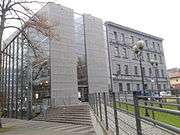 John Paul II Library
John Paul II Library
References
- "Local Data Bank". Statistics Poland. Retrieved 27 June 2020. Data for territorial unit 1661000.
- "Opole - description, location, history". Mapofpoland.net. Retrieved 26 October 2017.
- "Archived copy". Archived from the original on 2016-10-09. Retrieved 2016-10-08.CS1 maint: archived copy as title (link)
- Witosławska, Agata. "Opole - history and song festivals". Poland.travel. Retrieved 26 October 2017.
- "- Studia w Opolu. Polska Wenecja może zaoferować Wam nie tylko wspaniałe widoki, ale także cudowną atmosferę". Studiowac.pl - wyszukiwarka uczelni i katalog kierunków studiów, matura z polskiego, poradniki maturalne. Retrieved 26 October 2017.
- Opole, Słownik geograficzny Królestwa Polskiego i innych krajów słowiańskich, Tom VII, nakł. Filipa Sulimierskiego i Władysława Walewskiego, 1880-1914
- B. Gediga, Początki i rozwój wczesnośredniowiecznego ośrodka miejskiego na Ostrówku w Opolu, Slavia Antiqua t. 16, Wrocław 1970.
- W. Dziewulski, F. Hawranek, Opole - Monografia miasta, Instytut Śląski Opole 1975, p. 57.
- This opinion is shared i.e. by W. Dziewulski, F. Hawranek, Opole - Monografia miasta, Instytut Śląski Opole 1975, p. 57 and G. A. Stenzel, Geschichte Schlesiens, T1. 1, Breslau 1853, p. 41. The opposite opinion is presented i.e. by K. Buczek, Targi i miasta na prawie polskim (okres wczesnośredniowieczny), Wrocław 1964, p. 114.
- W. Dziewulski, F. Hawranek, Opole - Monografia miasta, Instytut Śląski Opole 1975, pp. 58–60.
- W. Dziewulski, F. Hawranek, Opole - Monografia miasta, Instytut Śląski Opole 1975, p.78.
- W. Dziewulski, F. Hawranek, Opole - Monografia miasta, Instytut Śląski Opole 1975, p.159.
- W. Dziewulski, F. Hawranek, Opole - Monografia miasta, Instytut Śląski Opole 1975, p. 263–268".
- T. Hunt Tooley, National Identity and Weimar Germany. Upper Silesia and the Eastern Border, 1918–1922, University of Nebraska Press, 1997, p. 15
- Spotkania z Zabytkami. 6, 2005, p. 21. (in Polish)
- Dorota Simonides, Jan Zaremba, Śląskie miscellanea: literatura-folklor, 2006, p. 82 (in Polish)
- The Expulsion of 'German' Communities from Eastern Europe at the end of the Second World War Archived 2009-10-01 at the Wayback Machine, Steffen Prauser and Arfon Rees, European University Institute, Florense. HEC No. 2004/1. p.28
- "German minority in Poland on the Ministry of Interior and Administration webpage". 2.mswia.gov.pl. Archived from the original on 25 February 2012. Retrieved 26 October 2017.
- "Rozporządzenie Rady Ministrów z dnia 19 lipca 2016 r. w sprawie ustalenia granic niektórych gmin i miast, nadania niektórym miejscowościom statusu miasta oraz zmiany nazwy gminy". isap.sejm.gov.pl. Retrieved 26 October 2017.
- "Opole się powiększa kosztem okolicznych wsi. Ich mieszkańcy protestują."To skok na kasę"". TVN24.pl. Retrieved 2017-10-04.
- "JEWISH CEMETERY IN OPOLE (GRANICZNA STREET)". Muzeum Historii Żydów Polskich. Retrieved 20 October 2012.
- "OPOLE: Opolskie". International Jewish Cemetery Project. Retrieved 20 October 2012.
- WSB University in Wrocław Archived 2016-03-01 at the Wayback Machine - WSB Universities
- "Nowe firmy Opole 2016, 2015, 2014 r., nowo rejestrowane firmy w Opolu i województwie opolskim". Coig.com.pl. Retrieved 30 January 2017.
- "Zainwestowali". Invest in Opole (in Polish). Retrieved 30 January 2017.
- "OPOLE Firmy i Instytucje". Info-net.com.pl. Retrieved 30 January 2017.
- "Historia Opola". Opole.pl (in Polish). Retrieved 30 January 2017.
- "Wyborcza.pl". opole.wyborcza.pl. Retrieved 30 January 2017.
- "Drogeria Rossmann - województwo opolskie". Rossmann.pl (in Polish). Retrieved 30 January 2017.
- "Galeria Opolanin Opole". Galeria-opolanin.pl. Retrieved 30 January 2017.
- "Miasta partnerskie". opole.pl. Opole. Retrieved 2020-03-04.
- The Columbia Electronic Encyclopedia. "Opole". Columbia University Press. Accessed June 4, 2006.
External links
| Wikivoyage has a travel guide for Opole. |
| Wikimedia Commons has media related to Opole. |
- Opole - Official Tourist Information
- Municipal website
- Urban development of Opole in the Historical-Topographical Atlas of Silesian Towns
- Jewish Community in Opole on Virtual Shtetl
- Webcam showing Krakowska Street in Opole (in Polish)
- CityOn.pl - things to do in Opole (in Polish)
- Culture: Amfiteart Opole
- Culture: KFPP Opole



